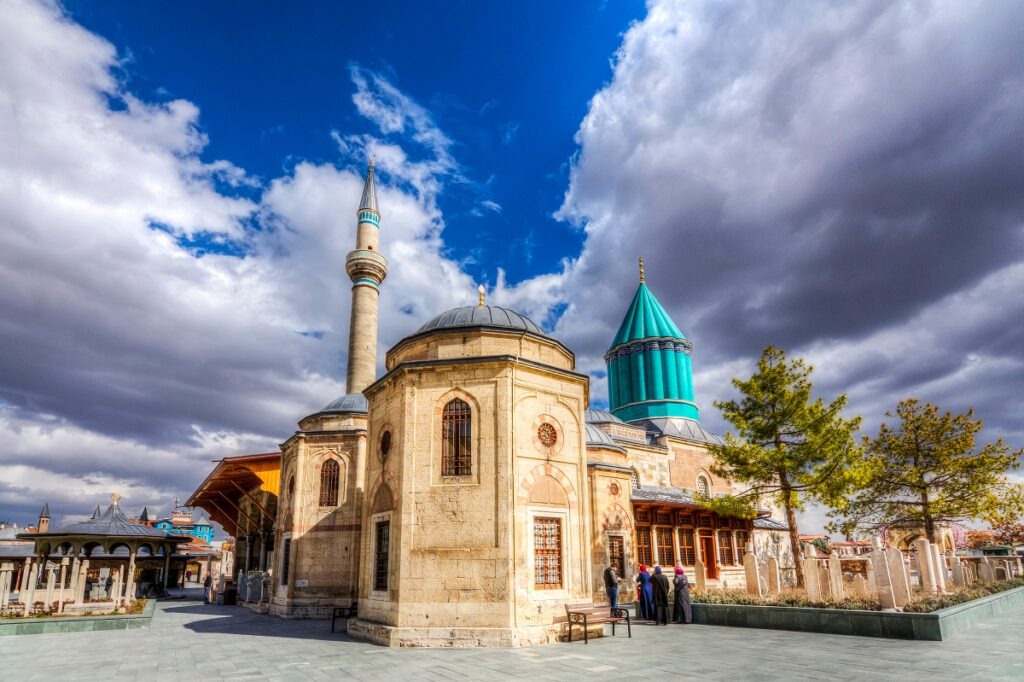Mevlana Museum Konya: Where Love Transcends Time

In the heart of Turkey’s central Anatolian region, amidst the bustling city of Konya, lies a sanctuary of spiritual enlightenment and poetic beauty—the Mevlana Museum. Dedicated to the memory of Jalal ad-Din Muhammad Rumi, the 13th-century Sufi mystic and poet known simply as Mevlana or Rumi, this sacred site has been a place of pilgrimage and inspiration for centuries. From its tranquil courtyards and elegant domes to its ornate tombs and mesmerizing displays, the Mevlana Museum Konya offers visitors a journey into the heart of Sufi philosophy and the enduring legacy of one of history’s most beloved figures.
The Life and Legacy of Mevlana Rumi
Born in 1207 in the city of Balkh (now in present-day Afghanistan), Rumi was a prolific scholar, theologian, and poet who transcended the boundaries of religion and culture to become one of the most celebrated spiritual figures in the world. At the age of 25, Rumi’s life was forever changed when he met the wandering dervish, Shams al-Din Tabrizi, whose profound wisdom and spiritual guidance ignited a transformative journey of inner awakening and divine revelation.
Following Shams’ mysterious disappearance, Rumi devoted himself to the path of love and devotion, founding the Mevlevi Order of Sufism and composing thousands of verses of mystical poetry that continue to resonate with readers across the globe. Rumi’s teachings, encapsulated in his magnum opus, the “Mathnawi,” emphasize the importance of love, compassion, and spiritual union with the divine—a message that remains as relevant today as it was in Rumi’s time.
The Museum Complex
The Mevlana Museum complex encompasses a sprawling complex of buildings, courtyards, and gardens that reflect the rich architectural and cultural heritage of the Ottoman Empire. At its center lies the majestic green-tiled mausoleum of Mevlana Rumi, adorned with intricate calligraphy and geometric patterns that symbolize the unity of all creation.
Surrounding the mausoleum are a series of rooms and chambers that once served as living quarters for the dervishes of the Mevlevi Order, who followed Rumi’s teachings of love, humility, and selflessness. Today, these rooms have been converted into a museum that showcases artifacts, manuscripts, and personal belongings associated with Rumi and his followers, providing visitors with a deeper understanding of his life and teachings.
The Whirling Dervishes
One of the most iconic features of the Mevlana Museum is the sema, or ritual whirling dance, performed by the Mevlevi dervishes as a form of spiritual practice and meditation. Originating in the 13th century as a way to honor Rumi’s teachings and attain a state of ecstatic communion with the divine, the sema is a mesmerizing spectacle that captivates audiences with its beauty and grace.
During the sema ceremony, the dervishes, clad in flowing white robes and tall felt hats, whirl in graceful circles to the haunting strains of traditional Sufi music, symbolizing the rotation of the planets and the journey of the soul towards enlightenment. The ceremony is a powerful expression of unity, harmony, and transcendence, inviting participants to experience a profound sense of oneness with the universe.
Cultural Significance
The Mevlana Museum holds immense cultural and historical significance for the people of Turkey and the broader Muslim world, serving as a symbol of peace, tolerance, and spiritual enlightenment. Each year, thousands of pilgrims and tourists flock to Konya to pay their respects to Rumi and experience the transformative power of his teachings firsthand.
In addition to its religious and spiritual significance, the Mevlana Museum also plays a vital role in promoting interfaith dialogue and understanding, bringing together people of all backgrounds and beliefs to celebrate the universal values of love, compassion, and empathy. Through its exhibitions, concerts, and educational programs, the museum serves as a beacon of hope and inspiration for future generations, fostering a culture of mutual respect and appreciation for the diversity of human experience.
Practical Information
- Location: The Mevlana Museum is located in the heart of Konya’s city center, easily accessible by car, public transportation, or on foot.
- Hours: The museum is typically open to visitors daily, with varying hours of operation depending on the season. It’s advisable to check ahead for the latest opening times and any special events or closures.
- Admission: There is usually a nominal fee for admission to the museum and the sema ceremony, with discounts available for students, seniors, and groups. Tickets may also be purchased in advance online or at the museum’s ticket office.
In Conclusion
The Mevlana Museum Konya is more than just a historic landmark; it’s a living testament to the enduring legacy of Rumi and the transformative power of his teachings. Whether you’re a devout follower, a curious traveler, or simply a seeker of spiritual enlightenment, a visit to this sacred site offers a journey into the heart of Sufi mysticism and a deeper understanding of the universal truths that bind us all together. As Rumi himself once said, “Come, come, whoever you are. Wanderer, worshiper, lover of leaving. It doesn’t matter. Ours is not a caravan of despair. Come, even if you have broken your vows a thousand times. Come, yet again, come, come.”




